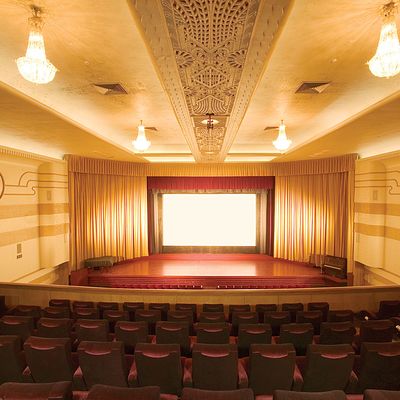
How was your summer? Hollywood’s was terrible. During a season movie studios count on for a little less than half their annual gross, domestic ticket revenue dropped 8 percent in July and 10 percent in August. Attendance is at a twenty-year low. Tent-pole films intended to prop up balance sheets instead produced red ink; the ill-conceived Battleship erased the profits of all other films Universal released last quarter, while Sony and Warner Bros. are expected to see hefty losses on Total Recall and Dark Shadows. Some of these economic wounds, true, are self-inflicted. But the movie business has reached what ICM partner Chris Silbermann calls “an inflection point.” Things have gone so haywire that the studios might not be able to break the cycle of ever-costlier flops without getting some outside relief. Funny as it sounds, Hollywood may need its own Washington bailout — in this case not in an injection of stimulus funds but a change to an old law that feeds many of its worst habits.
Here some history is helpful. In the golden age of the movie business — the thirties and forties — studios owned their own theaters and thus decided where their releases would play, forcing theaters outside their empires to buy films without even having seen them. Then, a Justice Department antitrust case led to the 1948 Supreme Court ruling known as United States v. Paramount Pictures, Inc. Studios were told they could own the tracks or the trains, but not both. Hollywood opted for the trains. With studios no longer able to ram an entire year’s worth of films — hits and stinkers alike — into helpless theaters, the stakes for each production went up.
Thanks to the Paramount decree, studios now wind up sharing film grosses more or less equally with theaters, but — and this is crucial — the two don’t collect at the same time. Because the studios take the bulk of the risk, they get paid first. Each company negotiates a different split, but it’s not uncommon for a studio to get 90 percent of the first weekend’s grosses, 80 percent of the second’s, and so on. Eventually the split reverses, favoring the theaters in the second half of a film’s run. The upshot is that studios have come to strongly favor movies with built-in demand — in the form of a superhero in the lead or a plot drawn from a hit book — and the potential to open with a bang. The calculus has gotten Hollywood addicted to so-called “event movies” — but making high-caliber event movies is not just expensive; it’s also just plain hard. What’s more, as Hollywood has burned through existing characters, it’s now moved onto franchises that have few actual fans.
“When I wanted to make Transformers, almost everyone rejected it and said, ‘It’s a stupid toy movie!’ Then we got it made, and it succeeded, so Hollywood thought the lesson was, ‘Let’s go make stupid toy movies!’ ” recalls Don Murphy, a producer on the film. “But that was not the lesson. It was not a stupid toy movie; the first Transformers was a very good movie. It also had 150 issues of a Marvel comic. It had 170 half-hour TV shows, and a fan base that had grown up with it in the eighties.” Compare this to Battleship, a brand that has no mythology. It’s a game, like poker or tiddledywinks.
One thing Battleship — and the broader genre it represents — does have, of course, is plenty of special effects. But to help pay for the pricey digital and 3-D projectors that display the studios’ retina-popping CGI creations, theaters have raised average ticket prices to record highs. Finally, the studios compound all these problems by creating a logjam of dubious blockbusters, for which audiences are expected to buy overpriced tickets, during the warmer months. “You can’t just keep piling up high-profile, expensive movies on top of one another,” grouses the vice-chairman of a major Hollywood studio (who declined to speak for attribution, fearing the wrath of movie theaters). “It’s not just the quality but the quantity of the pictures, too.” During the summer of 1982, there were fewer than 50 films released. By 2002, the number was 157. This year, there were an astonishing 214 summer movies.
CBS Films co-president Terry Press is among those who see letting studios own theaters again as a way out of the downward spiral. “I understand the antitrust of it all,” she says. “But there would be much more freedom to gauge how to release a movie.” The flexibility would be not just temporal but geographic. A film like Magic Mike, for example, underperformed in blue markets but hugely overperformed in red ones: St. Louis and Nashville saw leaps of more than 30 percent over typical ticket sales, while Kansas City saw a honking 75 percent box-office bump. In New York City and Los Angeles — where advertising and marketing costs are most expensive — Mike fell short of averages by 30 percent and 15 percent, respectively. If Warner Bros. controlled the big screens it was shown on, it could have adjusted for that and devoted resources to other productions.
Privately, other movie executives insist that having the ability to aim better will lead to fewer creative misses. Without the pressure of having to make as much money as possible as soon as possible, more inventive films would be able to take more time to catch on. Owning theaters could, in this vision, have Hollywood going back to Back to the Future. After 232 days in release, Robert Zemeckis’s 1985 classic finally reached $200 million ($428 million in today’s dollars), marking the slowest climb ever to that milestone. Few would argue that it wasn’t worth the wait.
*This article originally appeared in the September 24, 2012 issue of New York Magazine.

